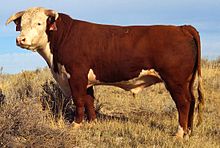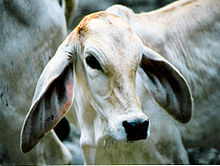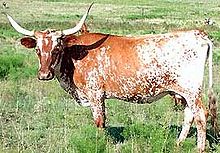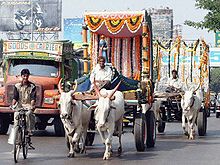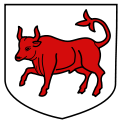
Cattle
About this schools Wikipedia selection
This Wikipedia selection is available offline from SOS Children for distribution in the developing world. Child sponsorship helps children one by one http://www.sponsor-a-child.org.uk/.
| Cattle | |
|---|---|
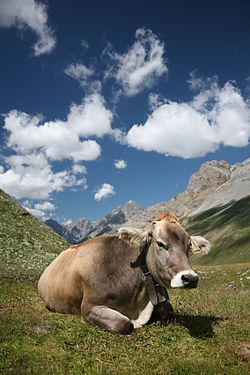 |
|
| A Swiss Braunvieh cow wearing a cowbell | |
| Conservation status | |
|
Domesticated
|
|
| Scientific classification | |
| Kingdom: | Animalia |
| Phylum: | Chordata |
| Class: | Mammalia |
| Subclass: | Theria |
| Infraclass: | Eutheria |
| Order: | Artiodactyla |
| Family: | Bovidae |
| Subfamily: | Bovinae |
| Genus: | Bos |
| Species: | B. primigenius |
| Subspecies: | B. p. taurus, B. p. indicus |
| Binomial name | |
| Bos primigenius Bojanus, 1827 |
|
| Trinomial name | |
| Bos primigenius taurus, Bos primigenius indicus |
|
 |
|
| Bovine range | |
| Synonyms | |
|
Bos taurus, |
|
Cattle (colloquially cows) are the most common type of large domesticated ungulates. They are a prominent modern member of the subfamily Bovinae, are the most widespread species of the genus Bos, and are most commonly classified collectively as Bos primigenius. Cattle are raised as livestock for meat (beef and veal), as dairy animals for milk and other dairy products, and as draft animals ( oxen or bullocks) (pulling carts, plows and the like). Other products include leather and dung for manure or fuel. In some countries, such as India, cattle are sacred. From as few as 80 progenitors domesticated in southeast Turkey about 10,500 years ago, an estimated 1.3 billion cattle are in the world today. In 2009, cattle became the first livestock animal to have a fully mapped genome.
Species
Cattle were originally identified as three separate species: Bos taurus, the European or "taurine" cattle (including similar types from Africa and Asia); Bos indicus, the zebu; and the extinct Bos primigenius, the aurochs. The aurochs is ancestral to both zebu and taurine cattle. Recently, these three have increasingly been grouped as one species, with Bos primigenius taurus, Bos primigenius indicus and Bos primigenius primigenius as the subspecies.
Complicating the matter is the ability of cattle to interbreed with other closely related species. Hybrid individuals and even breeds exist, not only between taurine cattle and zebu (such as the sanga cattle, Bos taurus africanus), but also between one or both of these and some other members of the genus Bos – yaks (the dzo or yattle), banteng, and gaur. Hybrids such as the beefalo breed can even occur between taurine cattle and either species of bison, leading some authors to consider them part of the genus Bos, as well. The hybrid origin of some types may not be obvious – for example, genetic testing of the Dwarf Lulu breed, the only taurine-type cattle in Nepal, found them to be a mix of taurine cattle, zebu, and yak. However, cattle cannot successfully be hybridized with more distantly related bovines such as water buffalo or African buffalo.
The aurochs originally ranged throughout Europe, North Africa, and much of Asia. In historical times, its range became restricted to Europe, and the last known individual died in Masovia, Poland, in about 1627. Breeders have attempted to recreate cattle of similar appearance to aurochs by crossing traditional types of domesticated cattle, creating the Heck cattle breed.
Word origin
"Cattle" did not originate as the term for bovine animals. It was borrowed from Old French catel, itself from Latin caput, head, and originally meant movable personal property, especially livestock of any kind, as opposed to real property (the land, which also included wild or small free-roaming animals such as chickens — they were sold as part of the land). The word is closely related to " chattel" (a unit of personal property) and "capital" in the economic sense. The term replaced earlier Old English feoh "cattle, property" (cf. German: Vieh, Gothic: faihu).
The word "cow" came via Anglo-Saxon cū (plural cȳ), from Common Indo-European gʷōus ( genitive gʷowes) = "a bovine animal", compare Persian gâv, Sanskrit go, Welsh buwch. The genitive plural of cū is cȳna, which gave the now archaic English plural of "kine". The Scots language singular is coo or cou, and the plural is "kye".
In older English sources such as the King James Version of the Bible, "cattle" refers to livestock, as opposed to "deer" which refers to wildlife. "Wild cattle" may refer to feral cattle or to undomesticated species of the genus Bos. Today, when used without any other qualifier, the modern meaning of "cattle" is usually restricted to domesticated bovines.
Terminology
| Look up cattle or cow in Wiktionary, the free dictionary. |
In general, the same words are used in different parts of the world, but with minor differences in the definitions. The terminology described here contrasts the differences in definition between the United Kingdom and other British-influenced parts of world such as Canada, Australia, New Zealand, Ireland, and the United States.
- An "intact" (i.e., not castrated) adult male is called a bull. A wild, young, unmarked bull is known as a "micky" in Australia. An un branded bovine of either sex is called a "maverick" in the USA and Canada.
- An adult female that has had a calf (or two, depending on regional usage) is a cow.
- A young female before she has had a calf of her own and is under three years of age is called a heifer (pron.: / ˈ h ɛ f ər / HEF-ər). A young female that has had only one calf is occasionally called a first-calf heifer.
- Young cattle of both sexes are called calves until they are weaned, then weaners until they are a year old in some areas; in other areas, particularly with male beef cattle, they may be known as feeder calves or simply feeders. After that, they are referred to as yearlings or stirks if between one and two years of age.
- A castrated male is called a steer in the United States; older steers are often called bullocks in other parts of the world, but in North America this term refers to a young bull. Piker bullocks are micky bulls that were caught, castrated and then later lost. In Australia, the term "Japanese ox" is used for grain-fed steers in the weight range of 500 to 650 kg that are destined for the Japanese meat trade. In North America, draft cattle under four years old are called working steers. Improper or late castration on a bull results in it becoming a coarse steer known as a stag in Australia, Canada and New Zealand. In some countries, an incompletely castrated male is known also as a rig.
- A castrated male (occasionally a female or in some areas a bull) kept for draft purposes is called an ox (plural oxen); "ox" may also be used to refer to some carcass products from any adult cattle, such as ox-hide, ox-blood, oxtail, or ox-liver.
- A springer is a cow or heifer close to calving.
- In all cattle species, a female twin of a bull usually becomes an infertile partial intersex, and is a freemartin.
- Neat (horned oxen, from which neatsfoot oil is derived), beef (young ox) and beefing (young animal fit for slaughtering) are obsolete terms, although poll, pollard or polled cattle are still terms in use for naturally hornless animals, or in some areas also for those that have been disbudded.
- Cattle raised for human consumption are called beef cattle. Within the beef cattle industry in parts of the United States, the older term beef (plural beeves) is still used to refer to an animal of either sex. Some Australian, Canadian, New Zealand and British people use the term beast, especially for single animals when the sex is unknown.
- Cattle of certain breeds bred specifically for milk production are called milking or dairy cattle; a cow kept to provide milk for one family may be called a house cow or milker.
- The adjective applying to cattle in general is usually bovine. The terms "bull", "cow" and "calf" are also used by extension to denote the sex or age of other large animals, including whales, hippopotamuses, camels, elk and elephants
Singular terminology issue
Cattle can only be used in the plural and not in the singular: it is a plurale tantum. Thus one may refer to "three cattle" or "some cattle", but not "one cattle". No universally used singular form in modern English of "cattle" exists, other than the sex- and age-specific terms such as cow, bull, steer and heifer. Historically, "ox" was not a sex-specific term for adult cattle, but generally this is now used only for draft cattle, especially adult castrated males. The term is also incorporated into the names of other species, such as the musk ox and "grunting ox" (yak), and is used in some areas to describe certain cattle products such as ox-hide and oxtail.
"Cow" is in general use as a singular for the collective "cattle", despite the objections by those who insist it to be a female-specific term. Although the phrase "that cow is a bull" is absurd from a lexicographic standpoint, the word "cow" is easy to use when a singular is needed and the sex is unknown or irrelevant - when "there is a cow in the road", for example. Further, any herd of fully mature cattle in or near a pasture is statistically likely to consist mostly of cows, so the term is probably accurate even in the restrictive sense. Other than the few bulls needed for breeding, the vast majority of male cattle are castrated as calves and slaughtered for meat before the age of three years. Thus, in a pastured herd, any calves or herd bulls usually are clearly distinguishable from the cows due to distinctively different sizes and clear anatomical differences. Merriam-Webster, a US dictionary, recognizes the sex-nonspecific use of "cow" as an alternate definition, whereas Collins, a UK dictionary, does not.
Colloquially, more general nonspecific terms may denote cattle when a singular form is needed. Australian, New Zealand and British farmers use the term "beast" or "cattle beast". "Bovine" is also used in Britain. The term "critter" is common in the western United States and Canada, particularly when referring to young cattle. In some areas of the American South (particularly the Appalachian region), where both dairy and beef cattle are present, an individual animal was once called a "beef critter", though that term is becoming archaic.
Other terminology
 |
A cow's moo
|
| Problems listening to this file? See media help. | |
Cattle raised for human consumption are called " beef cattle". Within the beef cattle industry in parts of the United States, the term "beef" (plural "beeves") is still used in its archaic sense to refer to an animal of either sex. Cows of certain breeds that are kept for the milk they give are called " dairy cows" or "milking cows" (formerly "milch cows"). Most young male offspring of dairy cows are sold for veal, and may be referred to as veal calves.
The term "dogies" is used to describe orphaned calves in the context of ranch work in the American West, as in "Keep them dogies moving". In some places, a cow kept to provide milk for one family is called a "house cow". Other obsolete terms for cattle include "neat" (this use survives in " neatsfoot oil", extracted from the feet and legs of cattle), and "beefing" (young animal fit for slaughter).
An onomatopoeic term for one of the commonest sounds made by cattle is "moo", and this sound is also called lowing. There are a number of other sounds made by cattle, including calves bawling, and bulls bellowing. The bullroarer makes a sound similar to a territorial call made by bulls.
Anatomy
Cattle have one stomach with four compartments, the rumen, reticulum, omasum, and abomasum, with the rumen being the largest compartment. The reticulum, the smallest compartment, is known as the "honeycomb". Cattle sometimes consume metal objects which are deposited in the reticulum and irritation from the metal objects causes hardware disease. The omasum's main function is to absorb water and nutrients from the digestible feed. The omasum is known as the "many plies". The abomasum is like the human stomach; this is why it is known as the "true stomach".

Cattle are ruminants, meaning their digestive systems allows use of otherwise indigestible foods by regurgitating and rechewing them as "cud". The cud is then reswallowed and further digested by specialised microorganisms in the rumen. These microbes are primarily responsible for decomposing cellulose and other carbohydrates into volatile fatty acids cattle use as their primary metabolic fuel. The microbes inside the rumen also synthesize amino acids from nonprotein nitrogenous sources, such as urea and ammonia. As these microbes reproduce in the rumen, older generations die and their cells continue on through the digestive tract. These cells are then partially digested by the cattle, allowing them to gain a high-quality protein source. These features allow cattle to thrive on grasses and other vegetation.
The gestation period for a cow is nine months. A newborn calf weighs 25 to 45 kg (55 to 99 lb). The world record for the heaviest bull was 1,740 kg (3,840 lb), a Chianina named Donetto, when he was exhibited at the Arezzo show in 1955. The heaviest steer was eight-year-old ‘Old Ben’, a Shorthorn/ Hereford cross weighing in at 2,140 kg (4,720 lb) in 1910. Steers are generally killed before reaching 750 kg (1,650 lb). Breeding stock usually live to about 15 years (occasionally as much as 25 years). The oldest recorded cow, Big Bertha, died at the age of 48 in 1993.
A common misconception about cattle (particularly bulls) is that they are enraged by the colour red (something provocative is often said to be "like a red flag to a bull"). This is incorrect, as cattle are red-green colour-blind. The myth arose from the use of red capes in the sport of bullfighting; in fact, two different capes are used. The capote is a large, flowing, magenta and yellow cape. The more famous muleta is the smaller, red cape, used exclusively for the final, fatal segment of the fight. It is not the colour of the cape that angers the bull, but rather the movement of the fabric that irritates the bull and incites it to charge.
Having two kinds of colour receptors in the cone cells in their retinas, cattle are dichromatic, as are most other nonprimate land mammals.
A cow's udder contains two pairs of mammary glands.
Weight
Adult weights of cattle always depend on the breed. Smaller kinds, such as Dexter and Jersey adults, range between 272 to 454 kg (600 to 1,000 lb). Large Continental breeds, such as Charolais, Marchigiana, Belgian Blue and Chianina, adults range up to 635 to 1,134 kg (1,400 to 2,500 lb). British-breeds, such as Hereford, Angus, and Shorthorn, mature between 454 to 907 kg (1,000 to 2,000 lb), occasionally higher, particularly with Angus and Hereford.
Bulls will always be a bit larger than cows by a few extra hundred pounds. Chianina bulls can weigh up to 1,500 kg (3,300 lb); British bulls, such as Angus and Hereford, can weigh as little as 907 kg (2,000 lb) to as much as 1,361 kg (3,000 lb).
It is difficult to generalize or average out the weight of all cattle because different kinds have different averages of weights. However, according to some sources, the average weight of all cattle is 753 kg (1,660 lb). Finishing steers in the feedlot average about 640 kg (1,400 lb); cows about 725 kg (1,600 lb), and bulls about 1,090 kg (2,400 lb).
Cattle genome
In the April 24, 2009, edition of the journal Science, a team of researchers led by the National Institutes of Health and the US Department of Agriculture reported having mapped the bovine genome. The scientists found cattle have about 22,000 genes, and 80% of their genes are shared with humans, and they share about 1000 genes with dogs and rodents, but are not found in humans. Using this bovine "HapMap", researchers can track the differences between the breeds that affect the quality of meat and milk yields.
Domestication and husbandry
Cattle occupy a unique role in human history, domesticated since at least the early Neolithic. Modern genetic research suggests the entire modern domestic stock may have arisen from as few as 80 aurochs tamed in the upper reaches of Mesopotamia about 10,500 years ago near the villages of Çayönü Tepesi in southeastern Turkey and Dja'de el-Mughara in northern Iraq. They are raised for meat ( beef cattle), dairy products and hides. They are also used as draft animals and in certain sports. Some consider cattle the oldest form of wealth, and cattle raiding consequently one of the earliest forms of theft.
Cattle are often raised by allowing herds to graze on the grasses of large tracts of rangeland. Raising cattle in this manner allows the use of land that might be unsuitable for growing crops. The most common interactions with cattle involve daily feeding, cleaning and milking. Many routine husbandry practices involve ear tagging, dehorning, loading, medical operations, vaccinations and hoof care, as well as training for agricultural shows and preparations. Also, some cultural differences occur in working with cattle; the cattle husbandry of Fulani men rests on behavioural techniques, whereas in Europe, cattle are controlled primarily by physical means, such as fences. Breeders use cattle husbandry to reduce M. bovis infection susceptibility by selective breeding and maintaining herd health to avoid concurrent disease.
Cattle are farmed for beef, veal, dairy, and leather, and they are less commonly used for conservation grazing, simply to maintain grassland for wildlife – for example, in Epping Forest, England. They are often used in some of the most wild places for livestock. Depending on the breed, cattle can survive on hill grazing, heaths, marshes, moors and semidesert. Modern cattle are more commercial than older breeds and, having become more specialized, are less versatile. For this reason, many smaller farmers still favour old breeds, such as the Jersey dairy breed. In Portugal, Spain, southern France and some Latin American countries, bulls are used in the activity of bullfighting; Jallikattu in India is a bull taming sport radically different from European bullfighting, humans are unarmed and bulls are not killed. In many other countries bullfighting is illegal. Other activities such as bull riding are seen as part of a rodeo, especially in North America. Bull-leaping, a central ritual in Bronze Age Minoan culture (see Bull (mythology)), still exists in southwestern France. In modern times, cattle are also entered into agricultural competitions. These competitions can involve live cattle or cattle carcases in hoof and hook events.
In terms of food intake by humans, consumption of cattle is less efficient than of grain or vegetables with regard to land use, and hence cattle grazing consumes more area than such other agricultural production when raised on grains. Nonetheless, cattle and other forms of domesticated animals can sometimes help to use plant resources in areas not easily amenable to other forms of agriculture.
Sleep
The average sleep time of a domestic cow is about four hours a day.
Economy
The meat of adult cattle is known as beef, and that of calves is veal. Other animal parts are also used as food products, including blood, liver, kidney, heart and oxtail. Cattle also produce milk, and dairy cattle are specifically bred to produce the large quantities of milk processed and sold for human consumption. Cattle today are the basis of a multi-billion dollar industry worldwide. The international trade in beef for 2000 was over $30 billion and represented only 23% of world beef production. The production of milk, which is also made into cheese, butter, yogurt, and other dairy products, is comparable in economic size to beef production, and provides an important part of the food supply for many of the world's people. Cattle hides, used for leather to make shoes, couches and clothing, are another widespread product. Cattle remain broadly used as draft animals in many developing countries, such as India.
Environmental impact
A report from the Food and Agriculture Organization (FAO) states that the livestock sector is "responsible for 18% of greenhouse gas emissions". The report concludes, unless changes are made, the damage thought to be linked to livestock may more than double by 2050, as demand for meat increases. Another concern is manure, which if not well-managed, can lead to adverse environmental consequences. However, manure also is a valuable source of nutrients and organic matter when used as a fertilizer. Manure was used as a fertilizer on about 15.8 million acres of US cropland in 2006, with manure from cattle accounting for nearly 70% of manure applications to soybeans and about 80% or more of manure applications to corn, wheat, barley, oats and sorghum. Further, substitution of manure for synthetic fertilizers in crop production can be environmentally significant, as between 43 and 88 MJ of fossil fuel energy are used per kg of nitrogen in manufacture of synthetic nitrogenous fertilizers.
One of the cited changes suggested to reduce greenhouse gas emissions is intensification of the livestock industry, since intensification leads to less land for a given level of production. This assertion is supported by studies of the US beef production system, suggesting practices prevailing in 2007 involved 8.6% less fossil fuel use, 16.3% less greenhouse gas emissions, 12.1% less water use, and 33.0% less land use, per unit mass of beef produced, than those used in 1977. However, these numbers included not only feedlots, but also feed production, forage-based cow-calf operations, backgrounding before cattle enter a feedlot, and animals culled from the dairy industry.
The number of American cattle kept in confined feedlot conditions fluctuates. From January 1, 2002 through January 1, 2012, there was no significant overall upward or downward trend in the number of US cattle on feed for slaughter, which averaged about 14.046 million head over that period. Previously, the number had increased; it was 12.453 million in 1985. Cattle on feed (for slaughter) numbered about 14.121 million on January 1, 2012, i.e. about 15.5% of the estimated inventory of 90.8 million US cattle (including calves) on that date. Of the 14.121 million, US cattle on feed (for slaughter) in operations with 1000 head or more were estimated to number 11.9 million. Cattle feedlots in this size category correspond to the regulatory definition of "large" concentrated animal feeding operations (CAFOs) for cattle other than mature dairy cows or veal calves. Significant numbers of dairy, as well as beef cattle, are confined in CAFOs. CAFOs are defined as "new and existing operations which stable or confine and feed or maintain for a total of 45 days or more in any 12-month period more than the number of animals specified" where "[c]rops, vegetation, forage growth, or post-harvest residues are not sustained in the normal growing season over any portion of the lot or facility." They may be designated as small, medium and large. Such designation of cattle CAFOs is according to cattle type (mature dairy cows, veal calves or other) and cattle numbers, but medium CAFOs are so designated only if they meet certain discharge criteria, and small CAFOs are designated only on a case-by-case basis.
A CAFO that discharges pollutants is required to obtain a permit, which requires a plan to manage nutrient runoff, manure, chemicals, contaminants, and other wastewater pursuant to the Clean Water Act. The regulations involving CAFO permitting have been extensively litigated. Commonly, CAFO wastewater and manure nutrients are applied to land at agronomic rates for use by forages or crops, and it is often assumed that various constituents of wastewater and manure, e.g. organic contaminants and pathogens, will be retained, inactivated or degraded on the land with application at such rates; however, additional evidence is needed to test reliability of such assumptions . Concerns raised by opponents of CAFOs have included risks of contaminated water due to feedlot runoff, soil erosion, human and animal exposure to toxic chemicals, development of antibiotic resistant bacteria and an increase in E. coli contamination. While research suggests some of these impacts can be mitigated by developing wastewater treatment systems and planting cover crops in larger setback zones, the Union of Concerned Scientists released a report in 2008 concluding that CAFOs are generally unsustainable and externalize costs.
An estimated 935,000 cattle operations were operating in the USA in 2010. In 2001, the US Environmental Protection Agency (EPA) tallied 5,990 cattle CAFOs then regulated, consisting of beef (2,200), dairy (3,150), heifer (620) and veal operations (20). Since that time, the EPA has established CAFOs as an enforcement priority. EPA enforcement highlights for fiscal year 2010 indicated enforcement actions against 12 cattle CAFOs for violations that included failures to obtain a permit, failures to meet the terms of a permit, and discharges of contaminated water.
Grazing by cattle at low intensities can create a favourable environment for native herbs and forbs; in many world regions, though, cattle are reducing biodiversity due to overgrazing. A survey of refuge managers on 123 National Wildlife Refuges in the US tallied 86 species of wildlife considered positively affected and 82 considered negatively affected by refuge cattle grazing or haying. Proper management of pastures, notably managed intensive rotational grazing and grazing at low intensities can lead to less use of fossil fuel energy, increased recapture of carbon dioxide, fewer ammonia emissions into the atmosphere, reduced soil erosion, better air quality, and less water pollution.
Some microbes in the cattle gut carry out anaerobic process known as methanogenesis, which produces methane. Cattle and other livestock emit about 80 to 93 Tg of methane per year, accounting for an estimated 37% of anthropogenic methane emissions, and additional methane is produced by anaerobic fermentation of manure in manure lagoons and other manure storage structures. The 100-year global warming potential of methane, including effects on ozone and stratospheric water vapor, is 25 times as great as that of carbon dioxide. Methane's effect on global warming is correlated with changes in atmospheric methane content, not with emissions. The net change in atmospheric methane content was recently about 1 Tg per year, and in some recent years there has been no increase in atmospheric methane content. Mitigation options for reducing methane emission from ruminant enteric fermentation include genetic selection, immunization, rumen defaunation, diet modification and grazing management, among others. While cattle fed forage actually produce more methane than grain-fed cattle, the increase may be offset by the increased carbon recapture of pastures, which recapture three times the CO2 of cropland used for grain.
Health
Cow urine is commonly used in India for medical purposes. It is distilled and then consumed by patients seeking treatment for a wide variety of illnesses. At present, no conclusive medical evidence shows this has any effect.
Oxen
Oxen (singular ox) are cattle trained as draft animals. Often they are adult, castrated males of larger breeds, although females and bulls are also used in some areas. Usually, an ox is over four years old due to the need for training and to allow it to grow to full size. Oxen are used for plowing, transport, hauling cargo, grain-grinding by trampling or by powering machines, irrigation by powering pumps, and wagon drawing. Oxen were commonly used to skid logs in forests, and sometimes still are, in low-impact, select-cut logging. Oxen are most often used in teams of two, paired, for light work such as carting, with additional pairs added when more power is required, sometimes up to a total of 20 or more.
An ox is a mature bovine which has learned to respond appropriately to a teamster's signals. These signals are given by verbal commands or by noise (whip cracks). Verbal commands vary according to dialect and local tradition. In one tradition in North America, the commands are:
- "Get up": walk forward
- "Whoa": stop
- "Back up": go backwards
- "Gee": turn right
- "Haw": turn left

Oxen can pull harder and longer than horses. Though not as fast as horses, they are less prone to injury because they are more sure-footed.
Many oxen are used worldwide, especially in developing countries. About 11.3 million draft oxen are used in sub-Saharan Africa. In India, the number of draft cattle in 1998 was estimated at 65.7 million head. About half the world's crop production is thought to depend on land preparation (such as plowing) made possible by animal traction.
Religion, traditions and folklore
Hindu tradition

Cattle are venerated within the Hindu religion of India. According to Vedic scriptures they are to be treated with the same respect 'as one's mother' because of the milk they provide; "The cow is my mother" (Mahabharata) They appear in numerous stories from the Puranas and Vedas. The deity Krishna was brought up in a family of cowherders, and given the name Govinda (protector of the cows). Also Shiva is traditionally said to ride on the back of a bull named Nandi. In ancient rural India every household had a few cows which provided a constant supply of milk and a few bulls that helped as draft animals.
Observant Hindus, though they might eat meat of other animals, almost always abstain from beef, and the slaughter of cows is considered a heinous sin in mainstream Orthodox Hinduism. Slaughter of cows (including oxen, bulls and calves) is forbidden by law in several states of the Indian Union. McDonalds outlets in India do not serve any beef burgers. At one time, the death sentence was imposed for killing a cow in India. According to a Lodi News-Sentinel news story written in the 1960s, in then contemporary Nepal an individual could serve three months in jail for killing a pedestrian, but one year for injuring a cow, and life imprisonment for killing a cow.
Other traditions


- The Evangelist St. Luke is depicted as an ox in Christian art.
- In Judaism, as described in Numbers 19:2, the ashes of a sacrificed unblemished red heifer that has never been yoked can be used for ritual purification of people who came into contact with a corpse.
- The ox is one of the 12-year cycle of animals which appear in the Chinese zodiac related to the Chinese calendar. See: Ox (Zodiac).
- The constellation Taurus represents a bull.
- An apocryphal story has it that a cow started the Great Chicago Fire by kicking over a kerosene lamp. Michael Ahern, the reporter who created the cow story, admitted in 1893 that he had fabricated it for more colorful copy.
- On February 18, 1930, Elm Farm Ollie became the first cow to fly in an airplane and also the first cow to be milked in an airplane.
- The first known law requiring branding in North America was enacted on February 5, 1644, by Connecticut. It said that all cattle and pigs had to have a registered brand or earmark by May 1, 1644.
- The akabeko (赤べこ, red cow) is a traditional toy from the Aizu region of Japan that is thought to ward off illness.
- The case of Sherwood v. Walker—involving a supposedly barren heifer that was actually pregnant—-first enunciated the concept of mutual mistake as a means of destroying the meeting of the minds in contract law.
- The Fulani of West Africa are the world's largest nomadic cattle-herders.
- The Maasai tribe of East Africa traditionally believe all cows on earth are the God-given property of the Maasai.
In heraldry
Cattle are typically represented in heraldry by the bull.
Population
The world cattle population is estimated to be about 1.3 billion. The following table shows the cattle population in 2009
Africa has about 20,000,000 head of cattle, many of which are raised in traditional ways and serve partly as tokens of their owner's wealth.
| Region | Cattle population |
|---|---|
| India | 281,700,000 |
| Brazil | 187,087,000 |
| China | 139,721,000 |
| US | 96,669,000 |
| EU-27 | 87,650,000 |
| Argentina | 51,062,000 |
| Australia | 29,202,000 |
| Mexico | 26,489,000 |
| Russian Federation | 18,370,000 |
| South Africa | 14,187,000 |
| Canada | 13,945,000 |
| Other | 49,756,000 |

